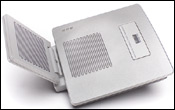RFC 2131, DHCP offers IP address and other parameters to IP hosts.
DHCP is a server/client setup where clients are given network addresses and other configuration parameters to dynamically configured hosts.
DHCP supports three mechanisms for IP address allocation:
- Static/Automatic allocation – Server leases a permanent IP address to a DHCP client.
- Dynamic allocation- Server leases an IP address to a client for a limited period of time or until the DHCP client gives up the IP address information
- Reserved / Manual allocation-Here the network administrator manually reserves and assigns an IP address to a client and the Server conveys the assigned address to the DHCP client.
As a CCNA student you are expected to know how to configure all options
DHCP messages re formatted based on the Bootstrap Protocol (BOOTP) message. Using this format ensures support for the BOOTP relay agent functionality and interoperability between BOOTP clients and DHCP Servers.
We use relay agents to eliminate to setup a unique Server on each subnet/VLAN or physical network segment.
By default, Cisco routers running Cisco IOS software include DHCP server and relay agent software.
=============
DHCP Server Overview
Cisco have developed for their IOS a full Server implementation which will assigns and manages IP addresses from administratively specified address pools configured on your router to DHCP clients.
Even if the Cisco Router cannot assign IP addresses to a client it can be configured to forward the request to one or more DHCP Servers once again manually configured by the network administrator.
The four basic steps that occur when a client requests an IP address from a DHCP Server.
A. The client sends a DHCPDISCOVER broadcast message to locate a Server.
B. A DHCP Server offers configuration parameters (such as an IP address, a MAC address, a domain name, and a lease for the IP address) to the client in a DHCPOFFER unicast message.
C. A DHCP client might be offered IP host information from many DHCP Servers. The client could accept any of these offers, but the will normally accept the very first offer it receives.
Note: Any offer from the DHCP Server is not a guaranteed until the DHCP client has had a chance to formally request the address but the server will normally reserves the address until the client does request it
D. The DHCP client then returns a formal request for the offered IP address to the Server in a DHCPREQUEST broadcast message.
E. In return the Server will confirm that the IP address has been allocated to the client by returning a DHCPACK unicast message to the client. The reason that the request for the offered IP address (the DHCPREQUEST message) which is issued by the DHCP client is sent as a broadcast is so that every other DHCP Server which may have received the initial DHCPDISCOVER broadcast message from the client can now reclaim the IP addresses that they had offered to the DHCP client.
In the event that the configuration parameters which were initially offered by the server to the DHCP client in the DHCPOFFER unicast message are invalid; say a misconfiguration error exists, the DHCP client will returns a DHCPDECLINE broadcast message to the Server.
When the Server receives the DHCPDECLINE it will then issue to the DHCP client a DHCPNAK denial broadcast message, this means the originally offered configuration parameters will not be assigned. In the event that an error occurs during the negotiation of the IP configuration parameters or the DHCP client has taken too long in reply to the DHCPOFFER message the DHCP Server will assign the parameters to another DHCP client of the DHCP Server.
As a CCNA student you are expected to know understand all options
Why use a the DHCP server features on the Router?
- Trackable cost savings
By deploying the DHCP client on the outside interface on each remote site router will reduce internet costs. Static IP addresses are more costly to purchase than to use dynamically acquired addresses
- Less client configuration and centralised management
DHCP is very simple to setup on clients
Because the Server supports all of the DHCP client configurations for all sbnets several subnets, you only need to manage a single, central server when you need to make configuration parameter changes.
Before you start to configure configure the Cisco Server features on the router you will need to complete the following steps
- Determine which subnets and IP addresses that you will setup on the Server for it to assign along with which IP addresses that are to be excluded.
- Default routers
- Domain Name System (DNS) servers
- Decide on a DNS domain name.
As a CCNA student you are expected to know how to configure all options
Joe Spoto is a senior lecturer at Commsupport networks CCNA training in the United Kingdom. Joe teaches Cisco CCNA, CCNP, CCVP courses when he is not out on the road fixing and building networks, if you want to find out more about what we do at Commsupport please visit us at CCNA Course
Commsupport run free one day training sessions and free on-line webinars, CCNA training
Article Source: http://EzineArticles.com/?expert=Joe_Spoto










One Response
Hi
i need to know how can upgrade the ios on my router
and i need to know how to learn insatal cucm on the vmwer